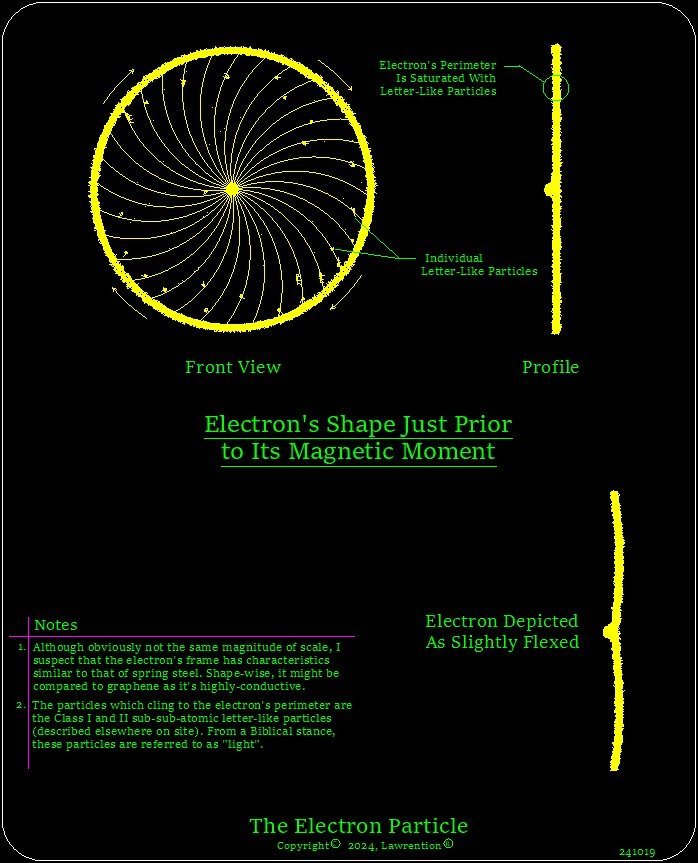Electrons are Unique
(Published in 2024, Rev. 241028)
| 🇨🇦 | 🕆 | 🇨🇦 | 🕆 | 🇨🇦 | 🕆 | L🇨🇦 |
Following is a recent write-up describing why electrons are unique. This topic is obviously slanted from a spiritual and biblical perspective. As of yet, there's no specific thread for physics on this site; although hopefully I will get the opportunity to do so. I've had a number of visions which relate directly to physics and am still parsing through the puzzle.
Electrons
Sub-Topic: Electrons are Unique
(Published 2024, version 241125)
As a basis for understanding electrons, consider that they function within a unique environment of spiritual letter-like particles (SLLPs). This is basically a spiritual environment of "light" particles which are sub-sub-atomic in size (sub2-atomic). The environment contains particles magnitudes smaller than an atom, and substantially smaller than the currently understood sub-atomic particles.
Under the discipline of physics, this spiritual environment might be considered to be part of the ether (also spelled as aether); so, it is a major component of the unseen realm. From a biblical-creation stance you can see my basis of reference here.
Further, electrons function within an environment that consists of heterogeneous particle-clouds consisting of SLLPs. These particles comprise the basis for both the spiritual and intelligence aspect of atomic structures.
Within particle physics, electrons are both fundamental and stable particles; so from this stance - they cannot be sub-divided into finer (known) components. Now, from an observational standpoint this may be true; however.... please humor me for a moment and allow me to explain.
What I'm about to reveal here, doesn't change either an electron's mass or its elemental charge of -1. In fact, it reinforces some of its well-understood characteristics. These include the electron's magnetic-moment and having it carry varying energy-states. For this last case, I'm referring quantum-states of an atom.
Under the electron's hood are particle-like sub-forces which "glue" it together. These sub-forces are comprised of something that looks like numerous-strings which may potentially fan out in multiple directions. At its very center is a solid hub, synonymous to the hub of a spoked wheel.
The electron's "strings" are not loose strings that could go on forever. Nor do I believe that they are sub-components of larger strings, as they are basically discrete groups. Likely the best description that I can give for now, is that the job of each of these discrete grouping of strings, is like that of a primordial seed. So, the center of an electron is essentially one of these seeds.
These primordial seeds are used within a host of standard-model particles. In fact, I believe that these primordial seeds are common to a number (if not most) of the standard-model particles in some form or fashion.
Further, I believe that these primordial seeds manifest themselves through the detection of quarks. Since bare-quarks attract mass and are virtually massless themselves... I believe that bare quarks are often-times synonymous with the vacuum-of-space. Bare quarks are basically primordial seeds. Once mass is garnered though one or more of these seeds (as they can easily be either paired or tripled momentarily), they reveal differing flavours within the quark family.
Although the hub of each electron appears like strings, I am hesitant to name them as such. Primarily since the topic of string-theory is so broad, that likely many of its components just won't apply. That being said, obviously the fundamental notion of strings within particle-physics is quite relevant, as differing lengths of strings accommodate various frequencies via natural rhythms.
Since the electron is so flexible and dynamic, as it mixes with SLLPs - there are various sub-frequencies continually at play. So, if you could listen to an electron in action - it's likely playing a tune.
Swirling about the perimeter of every electron, is a plurality SLLPs. These SLLPs are a homogeneous mix of Class I's & II's. Although both classes are similarly sized, a Class I particle houses more energy than Class II's (as they were created by dissimilar processes). The electron's environment is basically a sea of these sub2-atomic SLLPs.
The electron looks similar to that of a flexible and very wobbly wagon wheel. It has SLLPs rotating about its perimeter, whereby at its center - is its “glue”.
As the electron continuously spins, it’s the letter-like particles sticking to its perimeter which create the bulk of its mass. It continually oscillates within itself as well as within its sub2-atomic environment. Due to its inherent vibrational and dynamic character, it continuously attracts and releases SLLPs.
When an electron becomes “full” of these SLLPs, it is basically saturated of both mass and energy. I believe that at the peak of this saturation point is when it experiences its "magnetic moment".
Once the electron reaches its saturation point, it proceeds to relax. At this stage, it doesn’t attract any more SLLPs; but, in its relaxed state - its continual-spinning motion tends to discard loosely-bound SLLPs. These discarded particles remain free until they become attracted once again by either the same, or a different electron. Once an electron's relaxed state is over - its cycle once again resumes, and attracts further SLLPs.
I believe that electrons quickly oscillate between a fully-relaxed and fully-saturated state. How fast this occurs, relies totally upon their environment. As an analogy.... consider that an electron's change-of-state is its breathing mechanism. So, with every breath...... an electron will inhale and exhale a portion of its environment. As a consequence, electrons continually churn up the sub2-atomic sea. If this was a card game, I would say that electrons serve as a means of continually shuffling the deck of SLLPs.
It's the Class I particles versus those of Class II, which are the most energetic. Likewise, they are also the most intelligent. Because of this, Class I particles typically lead chemical reactions. Here, Class I particles can be considered to be the primary constituent in valence electrons. Whereby, the focus is not upon an atom's nucleus, but its perimeter.
Since each electron is capable of having a differing ratio of Class I & II particles, all electrons are unique. From our much-larger human vantage-point - electrons tend to assume characteristics garnered through their most recent "experience" (or environment).
Below, is the electron itself. Although not exactly as depicted, functional-wise - it's fairly close. To date, the electron is used on this site as an aid to explain the spiritual side of matter. At some point I will publish a section dedicated to particle physics; until then, health topics remain the number-one concern.




